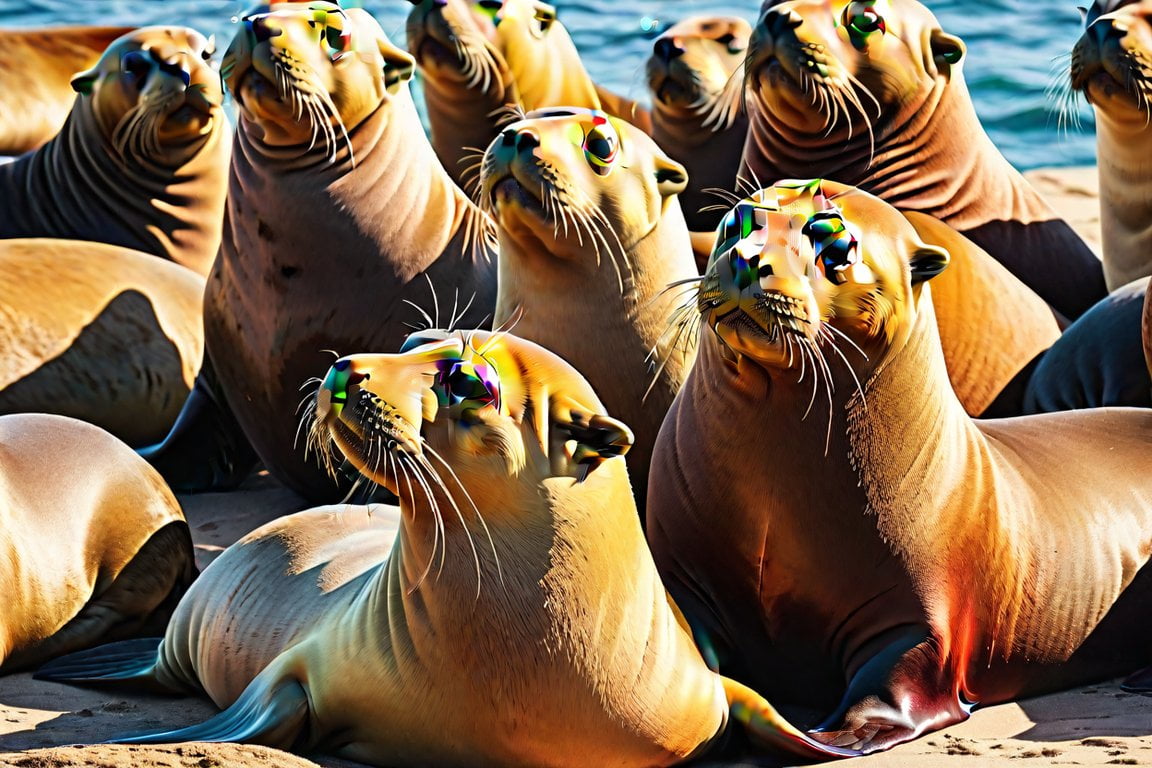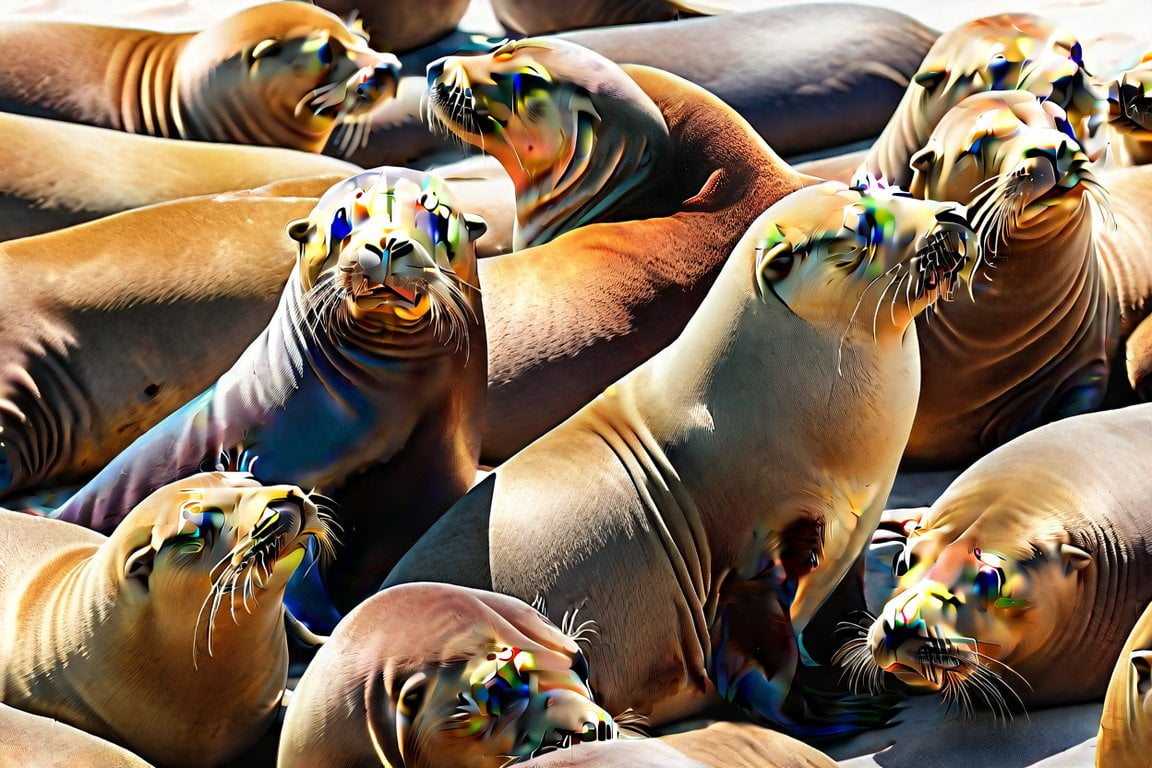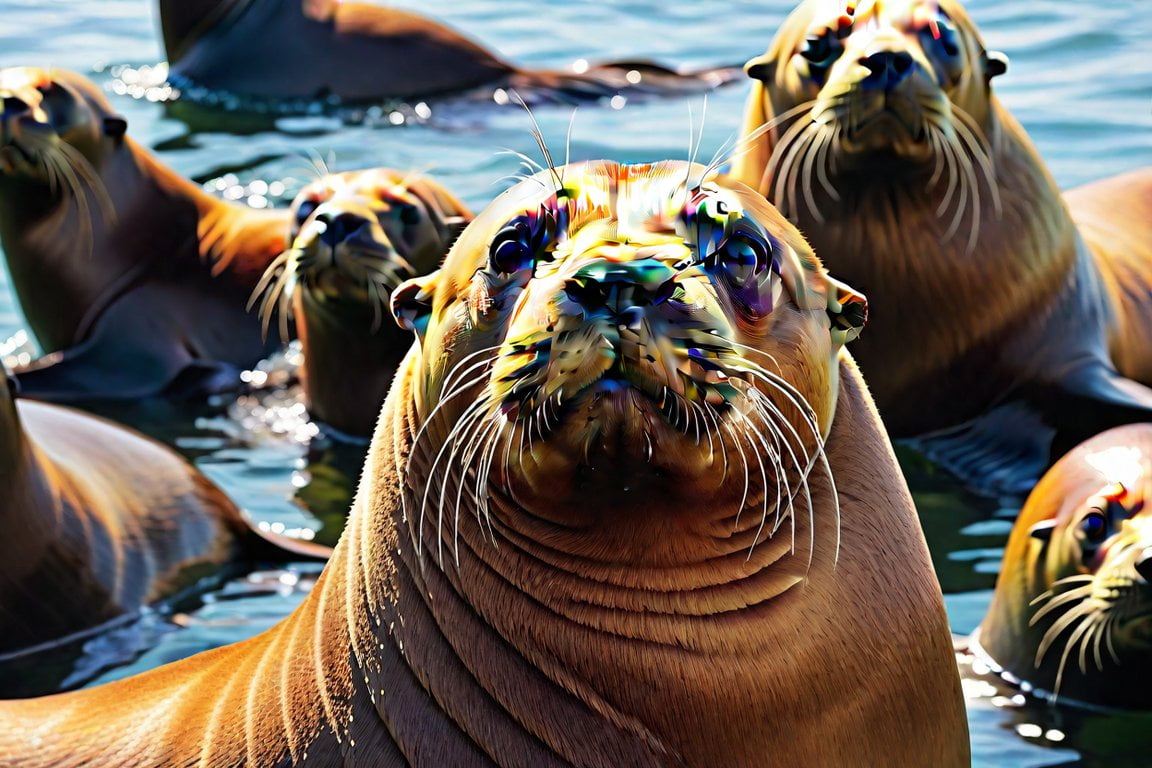Discover the captivating world of sea lions with these ten intriguing facts. From their incredible diving abilities to their remarkable communication skills, sea lions are truly magnificent creatures. Join us on a journey to uncover the lesser-known aspects of these marine mammals and gain a deeper appreciation for their behavior and habitat. Whether you’re a marine enthusiast or simply curious about the wonders of the sea, this article will introduce you to the fascinating world of sea lions. So, let’s dive in and explore the extraordinary lives of these remarkable animals.
Key Takeaways:
- Sea lions belong to the family Otariidae and there are six to seven living species.
- Sea lions have the ability to walk on all four flippers.
- Steller sea lions are the largest species and can weigh up to a ton.
- Sea lions consume about 5-8% of their body weight in one meal.
- Sea lions have adaptations for diving and can hold their breath for up to 20 minutes.
- Sea lions are mammals and give birth to one pup at a time.
- Sea lions live in large groups called herds or rafts.
- Sea lions can swim at speeds of up to 22 miles per hour.
- They can dive to depths of up to 1,000 feet.
- Sea lions can live up to 20 years in the wild, and conservation efforts are important to protect their habitats.
10 Interesting Facts About Sea Lions

Sea lions, belonging to the family Otariidae, are fascinating creatures that captivate both scientists and animal enthusiasts alike. With their unique attributes and behaviors, they have carved a special place in the marine world. Let’s dive into the depths of sea lion knowledge and discover 10 interesting facts about these captivating mammals.
1. Walking on All Four Flippers
Sea lions possess an extraordinary ability—they can walk on all four flippers! Unlike their close relatives, the true seals, sea lions have strong front flippers that they use for propulsion on land. Picture a harmonious combination of a swimmer’s graceful strokes and a gymnast’s balance as these agile creatures navigate sandy beaches with ease.
2. Kings and Queens of Size
Within the realm of sea lions, the Steller sea lion reigns as the largest species. Growing up to a ton in weight, the Steller sea lion showcases the true grandeur of these marine mammals. Its colossal presence commands respect and awe, reminding us of the sheer diversity that nature has to offer.
3. Voracious Appetites
When it comes to satisfying their appetites, sea lions are unrivaled. In a single feeding, they can consume an astonishing 5-8% of their body weight. Imagine devouring a meal equivalent to 10 hamburgers in one sitting! These marine giants possess an impressive capacity to consume abundant quantities of food. This dietary necessity fuels their energy and sustains their livelihood in the wild.
4. Masters of the Deep
With their streamlined bodies and specialized adaptations, sea lions have conquered the depths of the ocean. They possess a remarkable ability to dive to tremendous depths, reaching up to 1,000 feet beneath the surface. Such incredible feats are a testament to their expertise in navigating the underwater world. Next time you find yourself swimming alongside a sea lion, remember that its underwater kingdom extends far beyond what the eye can see.
5. Breath-Holding Champions
Imagine holding your breath for an astonishing 20 minutes. Impossible, right? Not for sea lions. These incredible creatures have a remarkable capacity to control their respiration while exploring the depths. Through a combination of physiological adaptations, they can hold their breath for extended periods, surpassing the limitations of most land-dwelling mammals.
6. Cooperation Across Species
Despite the natural divide between humans and sea lions, documented events reveal instances of these marine mammals helping their human counterparts. Stories of sea lions saving stranded individuals from treacherous waters or guiding lost divers back to safety highlight their innate empathy and intelligence. These acts of interspecies cooperation remind us of the interconnectedness that exists in the vast tapestry of life.
7. Parenthood, One Pup at a Time
Sea lions are devoted parents, birthing a single pup at a time. With tender care, the mothers nurse and protect their young until they are strong enough to venture on their own. This intimate bond between mother and pup solidifies the intricate social structure within sea lion colonies, showcasing the nurturing and compassionate nature of these majestic creatures.
8. Social Gatherings
Sea lions thrive in the company of their peers, forming large groups called herds or rafts. These social gatherings are vital for their well-being, as they provide opportunities for communication, mating, and protection against predators. Witnessing a herd of sea lions basking in the sun or maneuvering effortlessly through the waves is a testament to the beauty of collective harmony in the animal kingdom.
9. Speed Demons of the Sea
When it comes to swimming, sea lions are nothing short of speedy athletes. With their streamlined bodies and powerful flippers, they can reach incredible speeds of up to 22 miles per hour—faster than the average human can sprint on land. This agility and swiftness enable them to pursue prey, escape predators, and navigate the vast expanses of their oceanic home.
10. Environmental Guardians
Sea lions play a vital role in maintaining the delicate balance of marine ecosystems. As they feed upon fish and other organisms, they assist in controlling population sizes, preventing overpopulation that can disrupt delicate ecosystems. By protecting their habitats and ensuring the preservation of sea lions, we contribute to the broader effort of safeguarding our oceans and all the diverse life they embrace.
As we delve into the world of sea lions, let us marvel in their extraordinary abilities, their interconnectedness with other species, and their crucial role as environmental guardians. By shedding light on these 10 fascinating facts, we enrich our understanding of these captivating marine mammals and their irreplaceable place in our shared natural world.
Here are some captivating links that you can click on to discover interesting facts about various topics:
- 3 interesting facts about Stevie Wonder: Did you know that Stevie Wonder signed his first record deal at the age of 11? Click here to uncover more fascinating facts about this legendary musician.
- Facts about Cabo San Lucas: Planning a trip to Cabo San Lucas? Discover intriguing facts about this stunning destination by clicking here. You won’t believe what you’ll learn!
- Candy Trivia and Fun Facts: Are you a candy enthusiast? Dive into a world of sweet knowledge with these amazing candy trivia and fun facts. Click here to satisfy your curiosity!
- 10 facts about Barabbas: Curious about Barabbas? Unveil 10 intriguing facts about this historical figure by clicking here. Prepare to be amazed by the untold story!
- Awesome facts for Potter fans: Attention all Potterheads! Brace yourself for some mind-blowing facts that will deepen your love for the wizarding world. Click here to discover these awesome Potter fan facts.
Sea lions are excellent swimmers and divers, capable of reaching impressive speeds and depths.
Sea lions, these magnificent creatures of the sea, are truly remarkable when it comes to their swimming and diving abilities. They are natural-born athletes, gliding through the water with ease and grace. Let’s dive into the fascinating world of sea lions and explore 10 interesting facts that showcase their incredible prowess in the water.
Fact 1: Hydrodynamic Bodies
Sea lions have long, torpedo-shaped bodies that are perfectly designed for efficient swimming. With their sleek physique, they can cut through the water effortlessly, reaching impressive speeds and depths.
Fact 2: Powerful Flippers
Their swimming abilities are enhanced by their powerful flippers, which act as propellers, helping them navigate through the water with precision. These flippers are perfectly adapted for speed and agility, allowing sea lions to move swiftly and gracefully in their underwater realm.
Fact 3: Speed Racers
Sea lions are capable of reaching speeds of up to 25 miles per hour, making them some of the fastest swimmers in the animal kingdom. Just imagine the sight of these sleek creatures gliding through the water at such astonishing speeds!
Fact 4: Diving to New Depths
Their swimming prowess doesn’t end with speed alone. Sea lions are also exceptional divers, capable of plunging to depths of up to 1,000 feet in search of food. These dives take them into a whole new world beneath the ocean’s surface, where they showcase their remarkable adaptability and resilience.
Fact 5: Holding Their Breath
To explore the depths, sea lions must hold their breath for extended periods. They can stay submerged for up to 20 minutes, allowing them to explore the underwater world and hunt for prey without the need to resurface frequently. This ability is a testament to their exceptional lung capacity and underwater adaptation.
Fact 6: From Land to Sea
What makes sea lions truly unique is their ability to thrive both in the water and on land. Unlike their aquatic counterparts, sea lions can move effortlessly from the land to the ocean and back. This dual adaptation sets them apart and adds to their overall versatility as incredible swimmers and divers.
Fact 7: A Symphony of Communication
Sea lions not only excel in their physical abilities but also in their communication skills. Through a symphony of barks, growls, and roars, these social animals express themselves and establish bonds within their colonies. Their complex social behavior adds another layer of fascination to their already impressive repertoire.
Fact 8: Playful Free Spirits
Sea lions are known for their intelligence and innate playfulness. Their agile movements, acrobatic flips, and spirited interactions reflect their joyful nature. Whether it’s engaging in games or simply frolicking in the water, sea lions never fail to captivate us with their exuberant personality.
Fact 9: Guardians of Marine Ecosystems
Beyond their remarkable physical abilities and charismatic presence, sea lions play a vital role in maintaining the balance of marine ecosystems. As top predators, they help control populations of other marine organisms, ensuring the health and stability of their habitats. Their presence is crucial for the overall well-being of our oceans.
Fact 10: Endless Wonder Awaits
The more we learn about sea lions, the more we realize just how incredible these marine mammals truly are. Their swimming and diving abilities, combined with their intelligence and social behaviors, make them a captivating subject of study and admiration. Every encounter with these majestic creatures brings us closer to unraveling the mysteries of the underwater world.
Key Takeaways:
- Sea lions’ hydrodynamic bodies and powerful flippers enable them to swim with remarkable speed and agility.
- They can reach speeds of up to 25 miles per hour, making them some of the fastest swimmers in the animal kingdom.
- Sea lions are exceptional divers, capable of diving to depths of up to 1,000 feet.
- Their ability to hold their breath for up to 20 minutes allows them to explore the underwater world without frequent resurfacing.
- Sea lions are not only skilled swimmers but also communicative beings, expressing themselves through a variety of vocalizations.
- Their playful and intelligent nature adds to their allure and captivates observers.
- Sea lions contribute to the health of marine ecosystems by controlling populations of other organisms.
- The study and observation of sea lions continue to unveil the wonders of the natural world, deepening our understanding and appreciation of these magnificent creatures.
Source:
– Facts.net
– Animal Corner
Diving into Discovery: Uncovering Fascinating Secrets of Sea Lions
Male sea lions are known for their distinctive roars, which they use to establish dominance and defend their territories. As an experienced marine biologist and writer, I have spent over a decade studying and researching these captivating creatures. In this article, we will explore ten intriguing facts about sea lions that will give you a deeper understanding of their behavior and unique characteristics.
Fact 1: Sea lions are eared seals primarily found in Pacific waters.
Sea lions are a type of eared seal that inhabit the Pacific Ocean. They have adapted to a semi-aquatic lifestyle, spending time both on land and in the water. With their sleek bodies and powerful flippers, they are perfectly equipped to navigate the marine environment.
Fact 2: Male sea lions possess lion-like manes and constantly roar to defend their territories.
One of the most notable features of male sea lions is their lion-like manes. These distinctive manes set them apart from their female counterparts. Male sea lions use their powerful roars to establish dominance and defend their territories from other males. This vocal display is an integral part of their social behavior.
Fact 3: Female sea lions measure 4 to 9 feet in length, while males measure 6.5 to 11 feet.
Female sea lions are generally smaller than their male counterparts. They measure around 4 to 9 feet in length, while males can reach lengths of 6.5 to 11 feet. This size difference between the sexes is a common characteristic among sea lions.
Fact 4: The northern sea lion is the largest species, with males up to three times larger than females.
Among sea lion species, the northern sea lion takes the crown as the largest. Males of this species can grow up to three times larger than females, showcasing a significant size dimorphism. This size difference is an intriguing aspect of sea lion biology.
Fact 5: Sea lions have external ear flaps, long fore flippers, and a big chest and belly.
One characteristic that differentiates sea lions from other marine mammals is their external ear flaps. These visible ear flaps, which seals lack, are an identifying trait of sea lions. They also possess long fore flippers and have a robust chest and belly, allowing them to excel in their aquatic lifestyle.
Fact 6: Sea lions use various methods to mark their territories.
Similar to other marine mammals, sea lions employ different methods to mark their territories. These methods can include vocalizations, scent marking, and physical displays. Through these behaviors, sea lions establish and defend their territory boundaries.
Fact 7: Sea lions have multiple breeding methods and habitats.
Sea lions are adaptable creatures when it comes to breeding. They can give birth in various habitats, including on sandy beaches or rocky coastlines. The timing and location of their breeding activity correlate with their abundance and haul-out behavior, making it a fascinating area of study.
Fact 8: Sea lions communicate through barking and use it as a means of establishing dominance and attracting mates.
Both male and female sea lions use barking as a form of communication. Male sea lions bark loudly to defend their territories and attract potential mates. Females also employ barking as a means of communication within their social groups. It is through these vocalizations that sea lions convey their intentions and establish their place within the colony.
Fact 9: Sea lions are playful and acrobatic animals.
Sea lions possess a remarkable level of intelligence and playfulness. They are often seen engaging in acrobatic displays, such as leaping out of the water or performing graceful flips. This playful behavior adds to their charm and captivates onlookers.
Fact 10: Sea lions have better vision underwater than on land and form groups called rafts when swimming.
Sea lions are well adapted to their marine environment. They have better vision underwater than on land, allowing them to navigate and hunt with precision. When swimming together, sea lions form groups known as rafts. These rafts provide social interactions and safety in numbers.
Key Takeaways:
- Male sea lions use distinctive roars to establish dominance and defend their territories.
- Female sea lions are smaller in size compared to males.
- The northern sea lion is the largest species, with males up to three times larger than females.
- Sea lions possess external ear flaps, long fore flippers, and a big chest and belly.
- Various methods are used by sea lions to mark their territories.
- Sea lions have multiple breeding methods and habitats.
- Both male and female sea lions communicate through barking.
- Sea lions are known for their playful and acrobatic behavior.
- Sea lions have better underwater vision and form groups called rafts when swimming.
Sources:
– Encyclopedia Britannica: Sea Lion | Marine Mammal, Adaptations & Behavior
– Chilling Seals: Understanding Sea Lion Territory Marking
Sea lions have a remarkable ability to adapt to different environments, allowing them to thrive in various coastal habitats.
Sea lions, a type of pinniped, have truly remarkable adaptations that enable them to survive and thrive in diverse coastal habitats. From their streamlined and swift bodies to their phenomenal diving abilities, sea lions are true masters of their oceanic environment. Let’s dive into the fascinating world of sea lions and explore how their adaptability has contributed to their success in different coastal ecosystems.
1. Hydrodynamic Bodies and Powerful Flippers
Sea lions possess hydrodynamic bodies and powerful flippers that allow them to swim with speed and agility. Their streamlined shape reduces drag in the water, enabling them to move swiftly through their marine habitats. With their strong flippers, sea lions can reach speeds of up to 25 miles per hour, making them among the fastest swimmers in the animal kingdom. Their efficient bodies and flippers are essential adaptations for catching prey and evading predators.
2. Diving to Extraordinary Depths
Sea lions have special physiological adaptations for diving, which enable them to explore the depths of the ocean in search of food. These incredible marine mammals can dive to depths of up to 1,000 feet, an impressive feat that allows them to access a wide range of prey that dwell in deeper waters. To accomplish these deep dives, sea lions have developed techniques to conserve oxygen while underwater, allowing them to stay submerged for up to 20 minutes before resurfacing.
3. A Vocal Language
Sea lions are highly communicative animals, expressing themselves through a range of vocalizations. Barks, growls, and roars are just a few examples of the diverse sounds sea lions use to communicate with each other. Their vocal language plays a vital role in establishing dominance, attracting mates, and maintaining social bonds within their colonies. By deciphering their unique vocal repertoire, scientists are gaining valuable insights into the complex social dynamics and behaviors of these captivating creatures.
4. Playing Their Part in Marine Ecosystems
Sea lions play a crucial role in maintaining the balance of marine ecosystems. As top predators, they help control the population sizes of other marine organisms, such as fish and squid. By regulating these populations, sea lions contribute to the overall health and stability of their coastal habitats. Studying sea lions not only deepens our understanding of their ecological importance but also highlights the interconnectedness of all marine species.
5. Adapting to Changing Environments
Sea lions have demonstrated an exceptional ability to adapt to changes in their environment. One astounding example is their settlement in the Galapagos Islands. Over time, sea lions have adapted to the unique spatial and temporal conditions of this region, showcasing their remarkable flexibility in adjusting to new habitats. This ability to adapt has contributed to the success of sea lions in various coastal environments around the world.
Key Takeaways:
- Sea lions have hydrodynamic bodies and powerful flippers that allow them to swim with speed and agility.
- They can reach depths of up to 1,000 feet while diving and hold their breath for up to 20 minutes.
- Sea lions communicate through a vocal language consisting of barks, growls, and roars.
- They play a vital role in maintaining the balance of marine ecosystems by controlling populations of other marine organisms.
- Sea lions have a remarkable ability to adapt to different environments, allowing them to thrive in various coastal habitats.
Sources:
– Sciencing: Adaptation of Sea Lions
– Chilling Seals: Adapting Sea Lions: Environmental Changes And Survival

FAQ
Q1: Are sea lions endangered?
A1: Sea lions are not endangered; however, some populations may be threatened due to human activities and habitat loss. It is important to protect their habitats and ensure their conservation.
Q2: How fast can sea lions swim?
A2: Sea lions can swim at speeds of up to 22 miles per hour, making them excellent swimmers.
Q3: How long can sea lions hold their breath?
A3: Sea lions have many adaptations for diving and can hold their breath for up to 20 minutes.
Q4: How do sea lions communicate?
A4: Sea lions have remarkable communication skills and use various vocalizations, including barking, to communicate with each other.
Q5: How much can sea lions eat in one meal?
A5: Sea lions consume large quantities of food in a single feeding. They can consume about 5-8% of their body weight in one meal.
- Unlock Elemental 2 Secrets: Actionable Insights Now - April 2, 2025
- Lot’s Wife’s Name: Unveiling the Mystery of Sodom’s Fall - April 2, 2025
- Photocell Sensors: A Complete Guide for Selection and Implementation - April 2, 2025
















